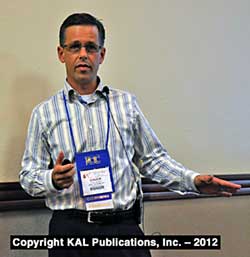54% of the adult population in the U.S. drinks coffee. This number is pretty stable.
46% of coffee consumed is gourmet and it has three time the growth of regular coffee. What this means is gourmet coffee is slowly eating away at traditional coffee market share.
25-59 year olds are the big consumers of coffee.
87% of coffee is consumed in the morning. We all knew that, but it's nice to see the numbers.

The QSR guys figured us out about 4 years ago. They said, 'We can sell coffee, too.' The first one was McDonald's and they had some fun with that big company out of Seattle. Wendy's and Burger King have followed and they've all made big marketing pushes and spent money in remodeling on their coffee offerings.
Iced coffee is the fastest growing segment with an increase of 15% in the past five years. It is a big consumption item in the afternoon/day part and is considered a treat and is popular with young consumers.
We've moved out of glass pots which cook the coffee and we're moving into thermal containers. Fresh coffee is perceived as coffee in a thermal, insulated server.
We are losing coffee sales to energy drinks and we're looking at diverse offerings to counter that. There are now triple shot mochas, coffee with nutriceutical additions.
Coffee houses haven't changed much since 1985. They've added wi-fi. But, other than that, they're pretty much the same. For the most part they're still selling coffee, mochas, and cappucchinos. So something is going to have to happen here.
The consumer is speaking to all of us and they're saying 'We want better coffee everywhere.'
Water quality is important. You have to change your water filters. And it's tough on your equipment. If you don't change your water filters, you can lose a big brewer in two years. It will just get eaten up inside.
Millennials are driving this — single cup brewing. They don't want to drink their parents' coffee and, in many cases, it's coffee house coffee. It's fresh ground, fresh extracted coffee, made one up at a time. It's more expensive. Coffee can be $5 to $16 per cup. A Columbian coffee is going to be less expensive than a Sumatran coffee.
C-stores are only capturing 4% of coffee consumers. You are capturing more than 4% of the food category. This doesn't mean you should beat yourself up. It means you have an opportunity.
The bottom quartile of c-store sell only 30 cups of coffee a day. The top quartile sells over 200 cups of coffee.
Coffee is usually the first prepared item that a consumer will try in a convenience store. If they don't like the coffee, they won't try other fresh food offerings.
Millennials represent 30% of all c-store buyers. Younger coffee drinkers show a preference for sweetened coffee drinks over plain coffee. They want something sweet, they want something fun, they want something flavored. They want to know where the coffee came from. If you can tell them a story about that coffee, if it's fair trade or Rainforest Alliance, they connect with that and they will buy that product.
The economy changed purchasing behavior and they haven't changed back. Consumers are not buying a latte. They're buying a large coffee and adding their own milk and sugar.
If you want to, you can use coffee to draw in more affluent customers into your store. The same is true with other fresh offerings.
Liquid concentrate is going to be a lower quality cup of coffee. There is no technology today that will extract the coffee without affecting the quality. Trust me, we're looking because everyone wants that.
I'm pretty sure Millennials will prefer freshly brewed iced coffee but it will be more trouble for operators to make the product. It depends on what is right for your store.
Trade magazine publishing featuring a “hometown paper” approach to industry news, events, and the people who make it all happen.